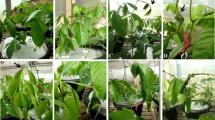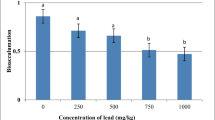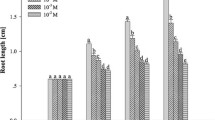Abstract
Heavy metals are some of the most important environmental pollutants. Excessive amounts of heavy metals adversely affect plant growth and development. Also, the presence of elevated levels of heavy metal ions triggers a wide range of cellular responses including changes in gene expression and synthesis of metal-detoxifying peptides. The overall objective of this research was to elucidate some microscopic effects of heavy metals on the formation, development, and structure of pollen, ovule, and embryo and also root proteins in Reseda lutea L. For this purpose, the vicinity of Ahangaran lead–zinc mine (Hamedan, Iran) was chosen as a polluted area where amount of some heavy metals was several times higher than the natural soils. Flowers and young buds were collected from non-polluted and polluted plants, fixed in FAA70, and studied during developmental stages by light microscopy. The results showed that heavy metals can cause some abnormalities during the pollen and ovule developmental process. The number of pollen grains was decreased, and their shape was changed. Increasing in thickness of the callosic wall and stabilizing of tapetum layer were observed in polluted plants. Asymmetrical formation of ovular integuments, degradation of egg apparatus, irregular formation of embryo sac, considerable vacuolation of embryonic cells, and degeneration of embryo in the late stage of heart-shaped embryo are the results of heavy metal pollution. For protein studies, young roots were harvested from plants exposed to pollution and non-exposed to pollution at the same time. Root proteins were extracted and studied by electrophoresis. The results revealed that some new proteins were synthesized in polluted samples that probably elevate plant tolerance to heavy metals.






Similar content being viewed by others
References
Igwe JC, Abia AA (2006) A bioseparation process for removing heavy metals from waste water using biosorbents. Afr J Biotechnol 5:1167–1179
Nedelkoska TV, Dorna PM (2000) Characteristics of heavy metal uptake by plant species with potential for phytoremediation and phytomining. Miner Eng 18:549–561
Bajguz A (2000) Effects of brassinosteroids on nucleic acids and protein in cultured cells in Chlorella vulgaris. Plant Physiol 38:209–215
Kaur S, Bhardwaj R (2004) Blockage of Zn-accumulation in seedlings of Brassica campestris L. by 24–epibrassinolide. Keystone Symposium on Plant Responses to Abiotic Stresses, Abstract No. 216: 64, Feb 19–24
Goyer RA (1997) Toxic and essential metal interactions. Annu Rev Nutr 17:37–50
Kabata-Pendias A, Pendias H (2000) Trace elements in soil and plant. CRC Press, Boca Raton
Sawidis T (2008) Effect of cadmium on pollen germination and tube growth in Lilium longiflorum and Nicotiana tabacum. Protoplasma 233:95–106
Chehregani A, Malayeri BE, Kavianpour F (2006) Effect of acid rain on the development, structure and viability of pollen grains. Pak J Biol Sci 6:1033–1036
Clemens S (2001) Molecular mechanisms of plant metal tolerance and homeostasis. Planta 212:475–486
Cobbett C, Goldsbrough P (2002) Phytochelatins and metallothioneins: roles in heavy metal detoxification and homeostasis. Annu Rev Plant Biol 53:159–182
Chehregani A, Kavianpour F (2007) Effects of acid rain on the developmental stages of ovules and seed proteins in bean plants (Phaseolus vulgaris L.). Am J plant Physiol 2:367–372
Chehregani A, Lari Yazdi H, Hoseini Sh (2007) Toxic effects of diesel exhaust particles on ovules and embryonic sac development in Phaseolus vulgaris L. Middle East Russ J Plant Sci Biotech 1:27–35
Malayeri B, Chehregani A, Mohsenzadeh F et al (2005) Effect of heavy metals on the development stages of ovule and embryonic sac in Euphorbia cheiradenia. Pak J Biol Sci 8:622–625
Yousefi N, Chehregani A, Malayeri B et al. (2011) Investigating the effect of heavy metals on developmental stages of anther and pollen in Chenopodium botrys L. (Chenopodiaceae). Biol Trace Elem Res. doi:10.1007/s12011-010-8701-6
Istvan PJ, Benton J Jr (1997) The handbook of trace elements. CRC Press, UK
Nouri J, Lorestani B, Yousefi N et al (2010) Phytoremediation potential of native plants grown in the vicinity of Ahangaran lead–zinc mine (Hamedan, Iran). Environ Earth Sci 62(3):639–644
Chehregani A, Mohsenzade F, Vaezi F (2009) Introducing a new metal accumulator plant and the evaluation of its ability in removing heavy metals. Toxicol Environ Chem 91:1105–1114
Baker AJM, Brooks RR (1989) Terrestrial higher plants which hyperaccumulate metallic elements—a review of their distribution, ecology and phytochemistry. Biorecovery 1:81–126
McGrath SP, Zhao FJ (2003) Phytoextraction of metals and metalloids from contaminated soils. Curr Opin Biotechnol 14:277–282
Yanqun Z, Yuan L, Jianjun C et al (2005) Hyperaccumulation of Pb, Zn and Cd in herbaceous grown on lead–zinc mining area in Yunnan. China Environ Int 31:755–762
Markert B (1994) Plants as bio monitors—potential advantages and problems. In: Adriano DC, Chen ZS, Yang SS (eds) Biogeochemistry of trace elements. Science & Technology Letters, Northwood, pp 601–613
Pugh RE, Dick DG, Fredeen AL (2002) Heavy metal (Pb, Zn, Cd, Fe, and Cu) contents of plant foliage near the Anvil Range lead/zinc mine, Faro, Yukon Territory. Ecotoxicol Environ Saf 52:273–279
Chehregani A, Malayeri B, Yousefi N (2009) Developmental stages of ovule and megagametophyte in Chenopodium botrys L. (Chenopodiaceae). Turk J Bot 33:75–81
Laemmli UK (1970) Cleavage of structural proteins during the assembly of the head of bacteriophage T4. Nature 227:680–685
Gaetke LM, Chow CK (2003) Copper toxicity, oxidative stress, and antioxidant nutrients. Toxicology 189:147–163
Hall JL (2002) Cellular mechanisms for heavy metal detoxification and tolerance. J Exp Bot 53:1–27
Avery SV (2001) Metal toxicity in yeasts and the role of oxidative stress. Adv Appl Microbiol 49:111–142
Kupper H, Setlik I, Spiller M et al (2002) Heavy metal-induced inhibition of photosynthesis: targets of in vivo heavy metal chlorophyll formation. J Phycol 38:429–441
Pandey N, Sharma CP (2002) Effects of heavy metals Cu, Ni and Cd on growth and metabolism of cabbage. Plant Sci 163:753–758
Astolfi S, Zuchi S, Passera C (2005) Effect of cadmium on H+-ATPase activity of plasma membrane vesicles isolated from roots of different S-supplied maize (Zea mays L.) plants. Plant Sci 169:361–368
Palmieri G, Cennamo G, Sannia G (2005) Remazol brilliant blue R decolourisation by the fungus Pleurotus ostreatus and its oxidative enzymatic system. Enzyme Microb Technol 36:17–24
Yousefi N, Chehregani A, Malayeri B et al. (2011) Effect of the heavy metals on the developmental stages of ovule and seed proteins in Chenopodium botrys L. (Chenopodiaceae). Biol Trace Elem Res. doi:10.1007/s12011-009-8386-x
Chehregani A, Mohsenzadeh F, Hosseini Sh (2011) Effect of water-soluble fraction of diesel exhaust particles on the development and protein pattern of pollen grains in bean plants (Phaseolus vulgaris L.). Toxicol Environ Chem 93(3):526–536
Majd A, Chehregani A (1992) Studies on developmental processes in ovules of soja (Glycine max L.) plants and effect of certain toxins and environmental pollutants. Acta Hortic 319:431–436
Majd A, Chehregani A, Moin M et al (2004) The effect of air pollution on structures, proteins and allergenicity of pollen grains. Aerobiology 20:111–118
Pacini E, Franchi GG, Hesse M (1985) The tapetum: its form, function and possible phylogeny in Embryophyta. Plant Syst Evol 149:155–185
Sawidis T, Reiss HR (1995) Effects of heavy metals on pollen tube growth and ultrastructure. Protoplasma 185:113–122
Buvat R (1989) Ontogeny, cell differentiation and structure of vascular plants. Springer, Berlin
Bocquet G (1959) The camylotropous ovule. Phytomorphology 9:222–227
Connor HE (1984) Gynodioecism in Sarcocornia quinqueflora (Chenopodiaceae) in New Zealand. New Zeal J Bot 22:433–439
Chehregani A, Noori M, Lari Yazdi H (2009) Phytoremediation of heavy metal polluted soils: screening for new accumulator plants and evaluation of removal ability. Ecotoxicol Environ Saf 72:1349–1353
Acknowledgement
The authors would like to express their appreciation to Bu-Ali Sina University for facilities and kind support. The authors wish to thank Prof. Shahin Zarre (University of Tehran) for his valuable comments.
Author information
Authors and Affiliations
Corresponding author
Rights and permissions
About this article
Cite this article
Mohsenzadeh, F., Chehregani, A. & Yousefi, N. Effect of the Heavy Metals on Developmental Stages of Ovule, Pollen, and Root Proteins in Reseda lutea L. (Resedaceae). Biol Trace Elem Res 143, 1777–1788 (2011). https://doi.org/10.1007/s12011-011-9009-x
Received:
Accepted:
Published:
Issue Date:
DOI: https://doi.org/10.1007/s12011-011-9009-x




